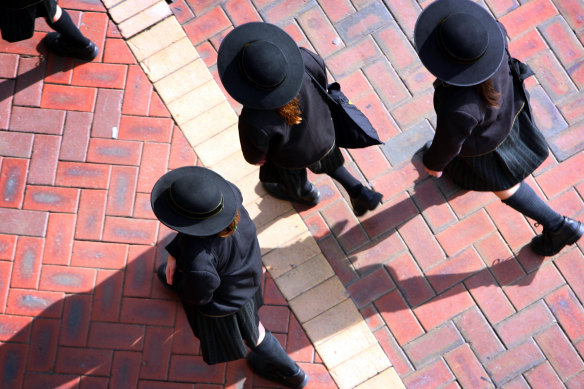By Lucy Carroll
Parents at private schools are bracing for fee hikes in 2025 as rising teacher wages heap pressure on school budgets and soaring operating costs are passed onto families.
Several Sydney schools have released their fee schedules for next year, including Danebank, which will increase charges by 9 per cent to just over $30,000 for year 12. St Andrew’s Cathedral School fees will climb 6.5 per cent to $44,525.
Mid- and low-fee schools in regional NSW have already locked in sharp increases of up to 24 per cent.

Education finance company Edstart said a survey of 150 NSW private schools found most will lift fees 5 per cent or more in 2025.Credit: Louie Douvis
Principals say non-government schools will need to increase salaries to match or eclipse public sector teacher wages after the state government last month awarded 95,000 public school educators a 10 per cent pay rise over three years.
Under the new pay deal, beginner teachers now earn a base salary of $87,550, and top-of-the-scale teachers earn almost $134,000. The agreement also includes the right for teachers to ignore calls and emails outside school hours and caps after-school staff meetings at one hour a week.
High-fee private schools increased fees by up to 12 per cent last year, a rise principals blamed on public system wage increases flowing through the education system.
Trinity Grammar headmaster Tim Bowden said: “Ultimately, the scarcity of teachers is driving up costs, and that will be borne by parents in all schools across the non-government sector.”
Another private school head said the “pressure is now on” to lift teacher pay again as competition for teachers increases.
Last year, Kambala became the first Sydney school to lift fees for year 9 above $51,000, making it the most expensive school in the country.
In a letter to parents last week, St Andrew’s Cathedral School council chair Michael Winram said fees will increase 6.5 per cent “predominantly due to staff wage changes following the Department of Education raising teacher salaries up to 15 per cent over the last two years”. Year 10 costs have tipped past $45,600 with levies.
Winram said the fees allow the inner-city school to attract and retain highly valued staff.

St Andrew’s Cathedral School says its 6.5 per cent rise in fees is a knock-on effect of government sector wage increases.Credit: Kate Geraghty
Data collected in June by education finance firm Edstart found 63 per cent of about 150 NSW private schools surveyed estimated their fees would rise by more than 5 per cent next year.
“We expect material increases in teacher wages in the independent and Catholic sector in 2025,” said Edstart chief executive Jack Stevens.
“Given government funding will not inflate at the same time to cover these, school fees will need to rise materially to cover increases in staffing costs,” he said, adding that insurance and construction expenditure was also putting upward pressure on fees.
The Herald revealed in June that the Independent Education Union was demanding pay rises for private school teachers to “maintain the traditional premium” above the public sector.
Sources familiar with the discussions say the Association of Independent Schools NSW (AISNSW) has offered 3 per cent above the new public sector wages, rising to 4.5 per cent in 2026. Negotiations are now deadlocked.
Some private schools, such as King’s, pay 14 per cent above the MEA (multi-enterprise agreement) rate for independent schools, partly due to teachers needing to attend extracurricular activities. Shore pays 16 per cent above.
Edstart also said private and Catholic schools were having to match government salary increases, with wages making up 70 per cent of a school’s costs.

Kambala lifted fees to above $50,000 for year 9 and 10 last year.Credit: Nick Moir
AISNSW chief executive Margery Evans said government schools, as the largest employers of teachers, have a huge influence on teacher salaries elsewhere.
“Independent schools are extremely conscious of the financial pressures facing their families and set their fees carefully as part of their annual budget process,” she said.
Evans estimates one in six private schools is “forced to accommodate a cut in their government funding of up to 4 per cent” every year, and are juggling a “shortfall while paying rising salaries and other costs”.
Some private schools in the Northern Rivers, such as Emmanuel Anglican College in Ballina, increased fees almost 24 per cent to $12,348 for year 12 next year. Xavier Catholic College raised charges about 21 per cent for next year.
Independent Education Union NSW branch secretary Carol Matthews said there were “several outstanding issues” involving bargaining for members represented by the AIS.
“Some teachers in independent schools are paid less than in government schools, and our members are keen to see these inequities resolved,” she said.
Separate negotiations are under way for Catholic systemic school staff, where pay has traditionally matched that of teachers in government schools.
From 2009 to 2023, the proportion of teachers employed at private schools rose by 3.1 percentage points and Catholic schools by 1.4; the proportion employed by public schools fell 4.5 points.
Private school fees increased by an average of more than 50 per cent in the decade to 2020.
The Morning Edition newsletter is our guide to the day’s most important and interesting stories, analysis and insights. Sign up here.